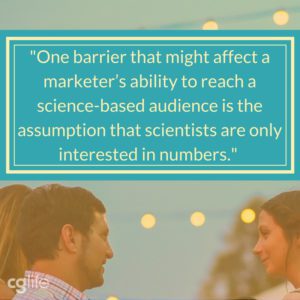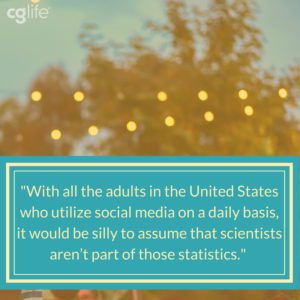In any type of marketing, there are three universal approaches a person must perform in order to be successful.
- It’s important to understand the target audience.
- You have to realize the problems the audience faces
- You have to offer solutions that solve those problems.
Although it’s not necessary to be a scientist to market a new diagnostic tool or pharmaceutical, understanding scientists along with the daily obstacles they face is a critical step for marketing.
Data Comes In Many Forms
Marketers often assume that scientists are only interested in numbers. Though there is truth in the importance of numbers and statistics in research, it’s more accurate to say that scientists are interested in data, rather than numbers. Moreover, it’s crucial to remember that there are multiple types of data; therefore, it’s more involved than simply looking at numbers or percentages. And no, we’re not talking about Big Data— although, it certainly is an essential game-player in marketing.  In the sciences, the most general way to classify data is into two categories: quantitative and qualitative. When the general public hears the word, “scientist,” the type of data and research that most readily erupts from our thoughts tends to fall under the umbrella of quantitative data. Quantitative data can be measured or counted numerically. On the other hand, qualitative data — data that describes character traits — tends to go unnoticed. However, the reality is that qualitative data plays an equally important role in science and discovery. This can be perfectly illustrated by Gregor Mendel — the scientist who laid the groundwork for studying genetics — when he conducted his research on pea plants. Many of his observations involved qualitative data, such as the shapes of the pods and seeds, and the position and color of the plants’ flowers. Without these observations, the numerical data alone would have been useless.
In the sciences, the most general way to classify data is into two categories: quantitative and qualitative. When the general public hears the word, “scientist,” the type of data and research that most readily erupts from our thoughts tends to fall under the umbrella of quantitative data. Quantitative data can be measured or counted numerically. On the other hand, qualitative data — data that describes character traits — tends to go unnoticed. However, the reality is that qualitative data plays an equally important role in science and discovery. This can be perfectly illustrated by Gregor Mendel — the scientist who laid the groundwork for studying genetics — when he conducted his research on pea plants. Many of his observations involved qualitative data, such as the shapes of the pods and seeds, and the position and color of the plants’ flowers. Without these observations, the numerical data alone would have been useless.
Persuading Scientists With Marketing
Society sometimes views scientists as unfeeling creatures lurking over pipettes and test tubes. You don’t have to look past the latest Hollywood blockbusters to see why. I love the Jurassic Park movies as much as the next person, but the big, bad scientist being responsible for every calamity is a bit overdone — and frankly, absurd. Scientists are people too. They enjoy art and outdoor recreational activities, neighborhood BBQs, and gatherings among family and friends. So how does this relate to marketing? The point is that scientists value various forms of data, including observations of shape, size, or color. Use this to your advantage and be bold with your colors and font. Don’t limit yourself to boring ads that only your dear mother would love. You may presume an advertisement riddled with charts and tables is what an estranged, eccentric person buried behind a microscope and pile of Petri dishes would like, but the terms “estranged” and “eccentric” don’t fit the average scientist.
Social Media Is For Everyone
Time is a fickle friend, even to scientists. Typically, a scientist’s day is whittled away in the lab or in front of a computer, examining data and writing reports. In the lab, it’s not uncommon for there to be a lag during tests or procedures as scientists wait for their results. And if the results are unusual, the tests may be run multiple times. For those reasons and others, research is often slow, reaching an extensive length before there is enough data to move forward. So what do scientists do with all this downtime? The same as everyone else — surf social media. Don’t make the mistake of presuming that a Microbiologist — let’s call him Louis — doesn’t listen to Pandora, check out the latest Reddit videos, or scroll through Pinterest for inspiration on how to revamp an old piece of patio furniture. Of course, Louis does. He even checked out the most recent tweet from Mark Hamill before clicking on a bicycle-gear ad and buying a new cycling kit. And he did all this while waiting for that batch of E. coli to incubate. Well done, Louis. Now if he can just tackle that Iron Man race he’s prepping for…
Going Places In Marketing Via The Social Media Road
When marketing to scientists it’s essential to remember that they are at the forefront of discovery and innovation, which means ideally they are always learning something new and applying new methods. The fact that scientists work in a field that requires a certain acceptance of change and interest in progress provides the upper hand to innovative marketers. Innovation is at the core of science, and what better way to appeal to scientists than offering solutions in modern, up-to-date ways, such as via social media? Data from Statista shows that 4.5 billion people around the world use social media actively with the most popular social media platform being Facebook. With all these people using social media on a daily basis, it would be silly to assume that scientists aren’t part of those statistics. Keep this in mind when targeting solutions for those in the science field and avoid placing limitations on your marketing strategy.
Data from Statista shows that 4.5 billion people around the world use social media actively with the most popular social media platform being Facebook. With all these people using social media on a daily basis, it would be silly to assume that scientists aren’t part of those statistics. Keep this in mind when targeting solutions for those in the science field and avoid placing limitations on your marketing strategy.
Marketing to Scientists Means Understanding Scientists
Understanding your target audience and their daily challenges are essential in providing them with the best solutions. If your target audience is in science, this will mean familiarizing yourself with those individuals’ work and work environments. This may seem like a no-brainer for most; after all, who doesn’t research their target audience? But rather than just googling life science or scientists, why not try some outside-the-box methods of getting to know your target audience? If you are acquainted with scientists, engineers, health professionals, or anyone in a science-related profession, ask them questions. Ask about their work; what parts they love about it, what parts they hate about it, or how their current positions differ from previous positions. Look for events in your local community and attend that nerd-night event coming up. Reach out to companies and organizations; most people are only too happy to talk about their work if politely approached. Some companies even give tours of their facilities. Although some require security clearances and are less inclined to open their doors to the public, there are other companies that welcome the community’s interest and will set up a tour. Other ways you can familiarize yourself with your science-based audience are by reading online blogs by science writers or scientists who talk about their work and typical work days. Any opportunity to gain new insight into the science realm will help lay a solid foundation for your strategies when marketing to scientists.
